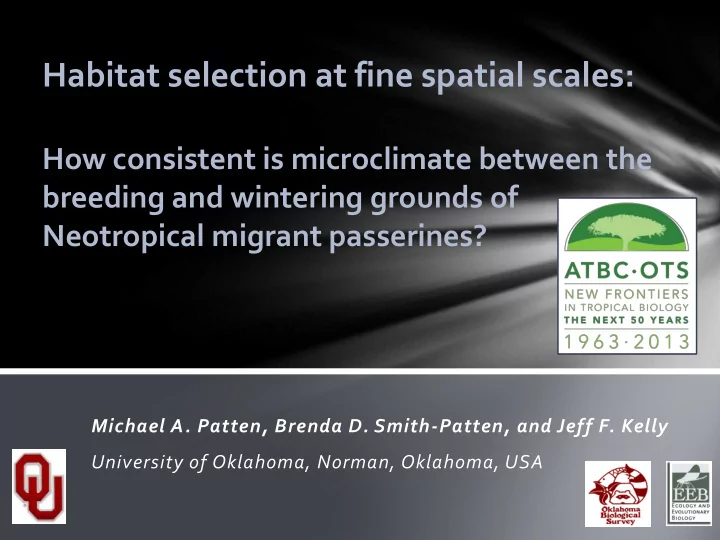

Habitat selection at fine spatial scales: How consistent is microclimate between the breeding and wintering grounds of Neotropical migrant passerines? Michael A. Patten, Brenda D. Smith-Patten, and Jeff F. Kelly University of Oklahoma, Norman, Oklahoma, USA
Correlates of extinction risk Persistence or extirpation? Patten & Smith-Patten (2011, Conservation Biology 25:1203 – 1211)
Mechanisms? A key potential reason is altered microclimate; e.g.: • higher temperature • stronger wind • increased light • lower humidity (i.e., desiccation) Patten & Smith-Patten (2011, Conservation Biology 25:1203 – 1211)
Residents La Milpa Field Station, Belize ( n = 129 plots) Las Cruces Biological Station, Costa Rica ( n = 103 plots)
Methods ambient temperature, relative humidity, heat index, wind speed, light intensity mini weather station light meter
Canonical Correspondence Analysis A multivariate ordination technique. orders sites along environmental gradients like other ordinations in the CA family, also orders species across the gradient A type of direct ordination. environmental variables are included in the analysis in the case of CCA, environmental variables are used in an associated multiple regression to constrain the algorithm that orders the sites (and species) Produces a biplot that shows how the environmental variables relate to the ordering of sites (or species).
Drivers of Assemblage Structure La Milpa 1 Canonical Variate II temp canopy 0 light VPD wind Las Cruces -1 1 Canonical Variate II temp canopy VPD wind -2 0 -1 0 1 2 light Canonical Variate I -1 -1 0 1 2 3 Patten & Smith-Patten (2012, Biological Conservation 155:85 – 93) Canonical Variate I
Light Mattered Most . . . Patten & Smith-Patten (2012, Biological Conservation 155:85 – 93)
What about Migrants? “We emphasize the need to consider how individuals move and interact with their environment throughout their annual cycle and over hemispheric scales .” – Renfrew et al. (2013, Diversity and Distributions 19:in press)
Migrants Ouachita National Forest, Oklahoma ( n = 28 plots) Rio Bravo Conservation and Management Area, Belize (La Milpa, n = 86 plots; Hill Bank, n = 16 plots)
Focal Species Black-and-white Warbler Mniotilta varia Kentucky Warbler White-eyed Vireo Geothlypis formosa Vireo griseus Hooded Warbler Red-eyed Vireo Setophaga citrina Vireo olivaceus
Analysis - Calculate means of microclimate variables • wind speed (m/s) • ambient temperature ( ºC) • vapor pressure density (humidity) • canopy cover (%) • light penetration (kLux) • heat index – although highly correlated with temperature . . . for occupied plots vs. available plots on both the breeding grounds and the wintering grounds. - Calculate ratios of occupied to available for each variable (ratios within ± 0.25 of 1.0 suggest no effect). - Compare ratios for breeding and wintering grounds.
White-eyed Vireo Vireo griseus Results wintering grounds canopy temperature VPD heat index wind light available 61.4 22.2 0.55 23.6 0.37 2.21 occupied 49.2 24.2 0.68 26.5 0.81 3.37 ratio 0.80 1.09 1.23 1.12 2.17 1.53 breeding grounds canopy temperature VPD heat index wind light available 67.1 25.3 1.34 26.0 0.34 3.86 occupied 69.1 25.5 1.50 26.1 0.58 5.23 ratio 1.03 1.01 1.12 1.01 1.68 1.35
Results species VPD wind light winter breed winter breed winter breed White-eyed Vireo 2.17 1.68 1.53 1.35 Black-and-white Warbler 0.58 0.57 0.58 Kentucky Warbler 0.74 0.70 0.45 0.25 0.48 Red-eyed Vireo 0.40 0.50 0.62 Hooded Warbler 1.36 1.34 No signal for canopy cover, ambient temperature, or heat index.
Results species VPD wind light winter breed winter breed winter breed White-eyed Vireo 2.17 1.68 1.53 1.35 Black-and-white Warbler 0.58 0.57 0.58 Kentucky Warbler 0.74 0.70 0.45 0.25 0.48 Red-eyed Vireo 0.40 0.50 0.62 Hooded Warbler 1.36 1.34 1.14 No signal for canopy cover, ambient temperature, or heat index.
Summary • Microclimate attributes are important aspects of habitat selection. • The extent of light penetration is the key microclimate variable. • Boreal migrants occupy similar light environments on their wintering grounds as on the breeding grounds. • Preference for high or low light environments varies across species. • White-eyed Vireo – high (forages in lower strata) • Black-and-white Warbler – low (mid-levels, but near trunks) • Kentucky Warbler – very low (largely terrestrial)
Conclusion Preservation or restoration of the light environment ought to be a major goal of conservation efforts for boreal migrants (and tropical resident) species of birds.
Recommend
More recommend